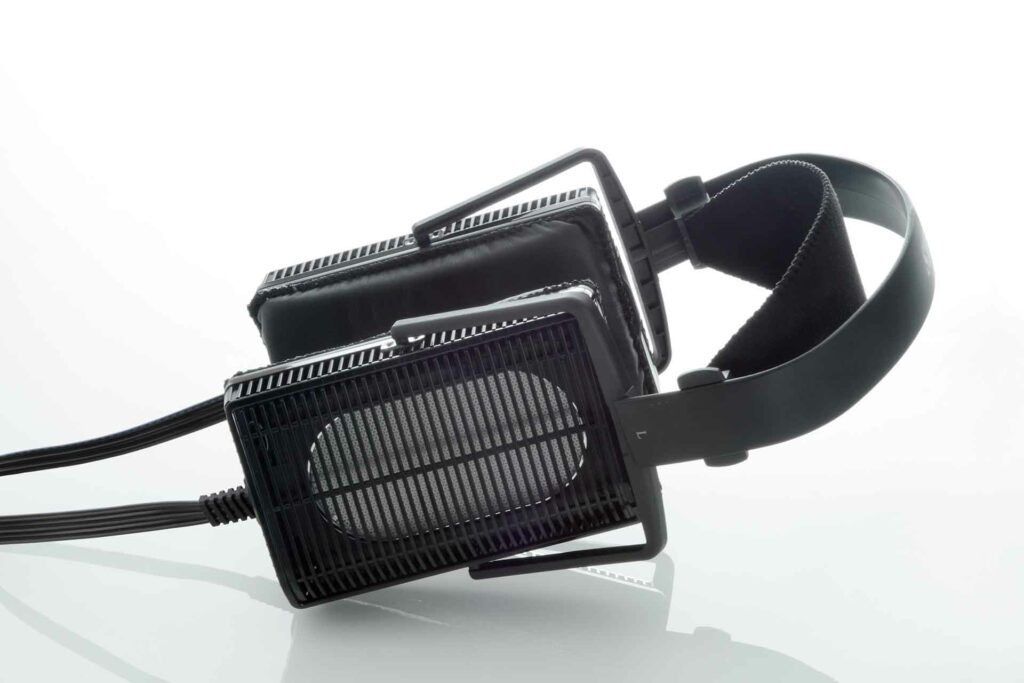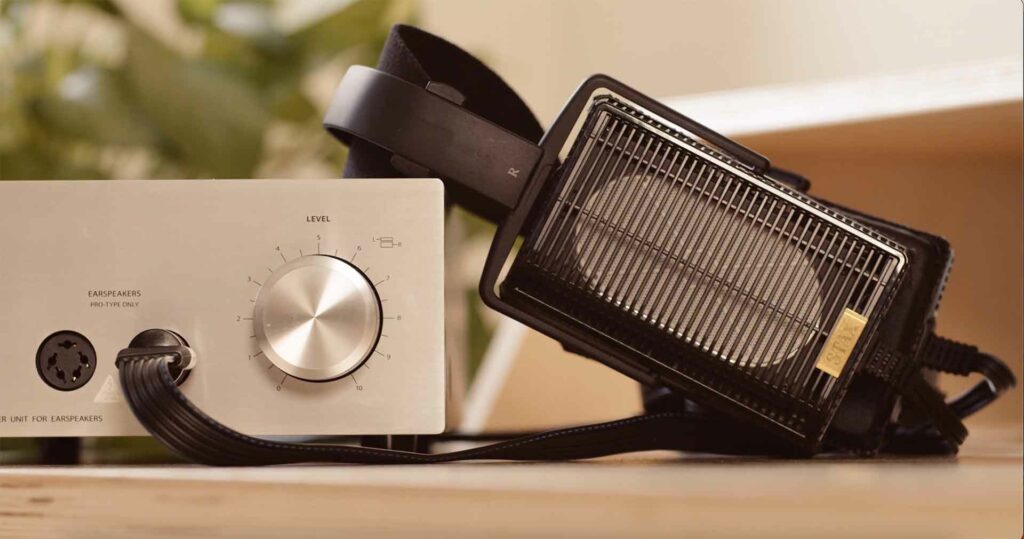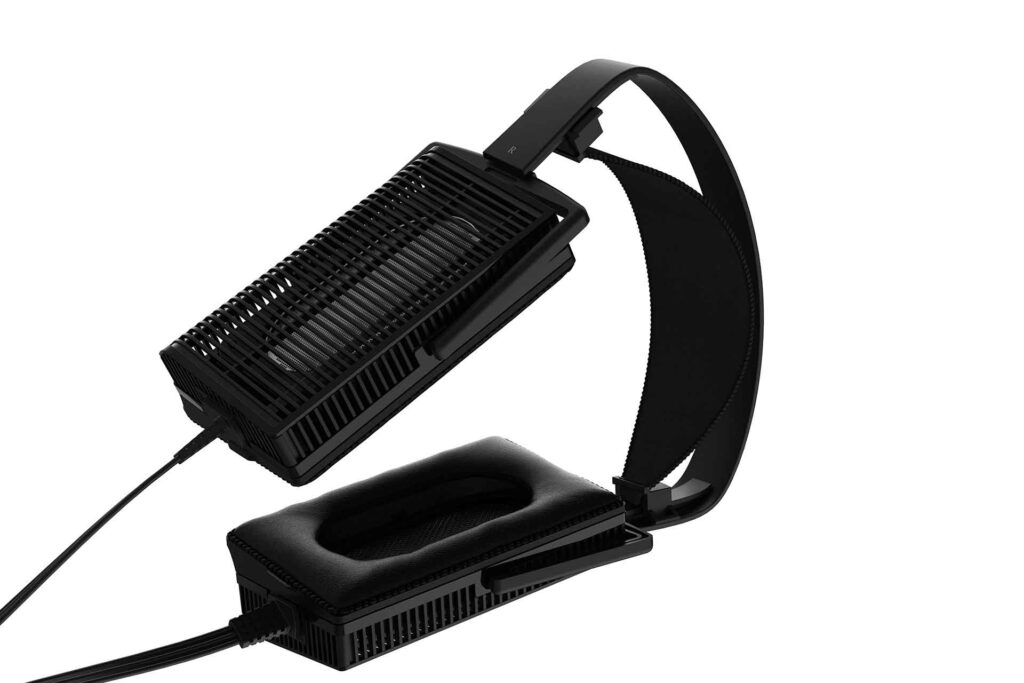Stax is known primarily for one kind of component: electrostatic headphones. Its first headphone/amplifier combination, the SRD-1 and SR-1, were released in 1960 and are legendary today. Currently the company has nine models ranging in price from the $455 to $6,200, and rather than referring to their offerings as headphones, they market them as “ear speakers.” This time out, we’ll dig into their least expensive ear speaker, the STAX SR-L300 (buy at Amazon). Like all Stax headphones, the SR-L300 requires either an adapter (which Stax no longer makes) that lets you use any power amplifier, or one of Stax’ dedicated ear-speaker amplifiers, which range in price from $6,825 for their top-of-the-line SRM-T8 BK to $1,299 for the SRM-400S, which Stax sent along with the SR-L300.

What Makes the Stax SR-L300 Electrostatic Headphones Special?
- The SR-L300 is based on the time-tested Stax Lambda design. It looks and feels very much like the SR-Lambda Pro model, which was introduced in 1982. The most noticeable improvement over the original Pro is the SR-L300’s quarter-inch longer opening in the earpads, which makes it easier for individuals with larger ears to fit comfortably inside.
- Stax SR-L300 are among the lightest electrostatic headphones available. They weigh a scant 448g including the cable. Once on your head, you can wear them for hours and hours with no discomfort, and that is a rarity with many super-high-performance headphones.
- The SR-L300 is the least-expensive Lambda design headphone Stax has ever made.Compared to the SR-Lambda Pro’s inflation-adjusted price of about $850 in 2022 dollars, the SR-L300 represents a savings of over $400.
- Besides provisions for larger ears, the SR-L300 offers other changes from the original design, including a greater range of angle adjustments and more setback from the ears.
- The SR-L300 are among the most open of open-backed headphones. There is literally nothing behind the driver to reflect sound back into the headphones.
- The sound of the Stax SR-L300s is unique. Nothing, except maybe another pair of electrostatic headphones, sounds like a pair of Stax ear speakers.
Why Should You Care About the Stax SR-L300 Headphones?
While single full-range dynamic drivers are ubiquitous in over-ear headphones, electrostatic headphones employ a different technology that offers major advantages due to the extremely low mass of their transducers. Unlike a dynamic driver, which must move a speaker cone assembly back and forth, an electrostatic drive employs an extremely thin piece of coated plastic no thicker than polyethylene food wrap sandwiched between two powered metal mesh screens whose generated energy moves the diaphragm back and forth within a very narrow range of motion. Listeners often describe electrostatic headphones as sounding “faster” than conventional dynamic headphones due to their low mass and low distortion.

Some Things You Might Not Like About the Stax SR-L300 Headphones
- The Stax Lambda headband design was/is physically delicate, given that it’s made primarily of plastic. Newer Stax headphone models use a more robust headband scheme, but the SR-L300 employs the original Lambda design, and judging by the mold marks, the exact same part as on my vintage Stax SR404 ear speakers, which were produced in 1998. That keeps the weight down but makes this one fragile. You won’t be throwing it into your backpack for a weekend trip
- The SR-L300 does not have a removable cable. The attached cable is exactly 2.5 meters long. For some uses that’s way too long. For others, it is just too short. You can get a five-meter accessory extension cable, but that will run you around $100.
- To really calculate the actual cost of the SR-L300, you must include a dedicated amplifier to drive them, which makes the retail price a bit of a misnomer. Stax’ least expensive amplifier, the SRM-400S costs $1,299. That puts even Stax’s least expensive offering into a much higher price class than other manufacturers’ dynamic entry-level models.
Listening to the Stax SR-L300 Electrostatic Headphones
I’ve been listening to music through Stax ear speaker systems for over 25 years. Stax were the first headphone I experienced that produced a credible three-dimensional image due to the phase-correct planar driver. For an example of the dimensional capabilities of a headphone like this, give a listen to “Heaven” by the late Avicii on Tidal 44.1/16. The piano and synthesizer are so wide they seem to extend outside of the actual confines of the SR-L300’s earcups. The low bass transients that permeate this track hold together even during the most riotous parts of the track. Also, during the dynamic peaks the image doesn’t vacillate but remains rock solid. While the low bass doesn’t have the pile-driver impact of the Focal Utopia II headphones, it does sound tight and well-controlled.
Over the holidays, I always listen to the Christopher Hogwood/Academy of Ancient Music’s rendition of Handel’s Messiah at least once. The 2014 remastered version in 96/24 resolution on Qobuz sounds excellent. All the soloists have a front and center presence and focus through the SR-L300, while the orchestra remains nicely arrayed behind them. Even during the dynamic peaks with the orchestra, chorus, and soloists going full-bore, the SR-L300 does a fine job of retaining all the detail and sparkle that was present during the quiet passages. On classical music recordings like this one, the SR-L300 has the special ability to retain all the air and delicacy of the strings and woodwinds.
The Watkins Family Hour’s most recent album, Vol. II via Qobuz in 44.1/16, has a wonderful cover of “Hypnotized” that opens with a guitar arpeggio, ambient organ, and lead vocals, which are soon joined by a dynamic drum kit and bass. Through to SR-L300, each instrument has its own unique pocket within the soundstage. Even at higher SPL levels, Sara Watkins’ vocals remained smooth and human without any additional harshness. The guitar part has a particular tautness to its attack that the SR-L300 preserved beautifully.
Does The Stax SR-L300 Electrostatic Headphones Have Any Resale Value?
By all means, yes. While I have not seen many SR-L300s go on the used market, I have seen earlier Lambda ear speakers for sale, usually at one-third to one-half of their original retail prices. Of course, condition is critical when it comes to resale value of a delicate, audiophile product like this. Stax ear speakers can be damaged by excessive SPLs, and often need to have their earpads replaced.

Some Additional Thoughts on Stax Amplifiers from Today As Well As Yesteryear
Since Stax has been making amplifiers for their ear speakers for as many years as they have been making ear speakers, they often come up on the used market at prices that are lower than new Stax amplifiers. I own a Stax SRM-007t amplifier made for the Japanese market (Stax cut the 120V leads on the SRM-007t’s transformers so they would not be transshipped to the United States and sold as new). I use mine with a 120 to 110 Volt convertor. This hack works great and cost me less than a new SRM-400S, but performs on a level approaching $3,400 SRM-700T. Also, older Stax amplifiers will drive older Stax ear speakers, which require 480 bias voltage, while new ones use 580 bias voltage. The SRM400S only has provisions for 580V, while my older SRM-700T has connections for both voltages.

Who is the Competition for the Stax SR-L300?
For many years, Stax had the electrostatic headphone market largely to itself. For a period of time, only Koss and Shure made competing electrostatic models. In the past couple of years, more audiophile headphone manufacturers have premiered electrostatic headphones. Audeze, Mr. Speakers, Warwick Acoustics, HIFIMAN, Shure, Koss, and Sennheiser all now make electrostatic headphones. With two exceptions, all are more expensive than a Stax SR-L300/SRM-400S combination. The Koss ESP950 ($999) is the least expensive electrostatic option currently available (there was also a limited edition Massdrop version at an even lower price). The HIFIMAN Jade II with amplifier is the only comparably priced option at $1,750. I have not heard either of these two headphone/amplifier combinations to make any direct comparisons but I plan to. All of the other electrostatic headphones currently available run at least $2,000 for the headset alone (they all require a dedicated amplifier at additional cost).
The reasons that electrostatic headphones are more expensive than dynamic driver headphones stem from their greater complexity and more involved manufacturing requirements. It takes more time and tighter tolerances to assemble an electrostatic element than merely attaching a finished driver to an earcup. Also, the need for a specialized amplifier ups the cost versus a more standard headphone designs that work with the amplifier circuit built into receivers, preamplifiers, and DACs.
Final Thoughts on the Stax SR-L300 Headphones
An entry-level audiophile product, regardless of the category, often entails ergonomic or performance compromises. The Stax SR-L300 is no exception. By utilizing its older basic Lambda design, Stax was able to create an electrostatic headphone with a cost that is almost half as much as their original version when accounting for inflation. Is it identical to the Stax SR-404 or earlier Stax Nova Signature (which I have also owned)? No. Changes include thinner, less robust ear pads, differently shaped enclosures, altered ear-to-driver distances, rougher leather used on the headband, a different fabric screen in front of the stators, and an odd plastic flap inside that covers the edge of the stator.
When I compared the SR-L300 with my pair of Stax SR-404 ear speakers, both driven by the Stax SRM-007t amplifier, they did not sound the same. The SR-L300 has a slightly warmed-up midbass and less overall low bass compared to the SR-404. Also, I felt that the SR-404 had a somewhat airier and more open treble range than the SR-L300. Finally, in comparison to the SR-L300, the SR-404 produced a more precise image with better, more three-dimensional spatial definition.
When I switched from my tube-based Stax SRM-007t to the Stax SRM-400S to compare the two headsets, some of the differences between the two vanished. The SR-404’s superior treble presentation was now more like that of the SR-L300 as was its dimensional characteristics. Overall, the sound was less satisfying when I used the SRM-400S instead of the SRM-007t. This brings up the audio phenomenon – scaling up. Better transducers, like the SR-404 headset, benefit from a better amplifier, such as the SRM-007t. I suspect if I had used Stax’s SRM-700T (their newest equivalent tube amplifier), I would have heard a similar uptick in audio quality.
Mike Longworth, the first historian and artist relations manager at Martin Guitar co. once told me “The primary competition for a new Martin guitar is a used Martin guitar.” The same can be said for Stax ear speakers and amplifiers. Here’s a Reverb listing for a pair of SR Lambda Pro headsets with matching SRM-1 Mark II amplifier for $699, or roughly half what you’ll pay for a new SR-L300/SRM400s combo. I’ve owned both of these in the past. The Stax SRM-1 Mark II and SRM-400S have a lot in common, sonically speaking. One of my first thoughts when I began listening through the SRM-400S amplifier was, “Boy this sure does remind me of my old SRM-1.”
It is also important to note that buying used, even when it’s gear as well-made as Stax, is often a risk. Stax headsets can be damaged by too high a signal level, which will not be obvious until you fire them up. If the Stax amp was “fixed” by Stax for 110 volts like my SRM-007t was, plugging it in to 120 without a step-down transformer could have caused hidden damage. So, while you can get into electrostatic headphones for less than the SR-L300/SRM-400S combo’s price tag, it will be at a substantially higher risk of ending up with gear in need of pricy repair. I recommend new Stax headphones for obvious reasons.
Circling back to the primary topic at hand – the Stax SR-L300 ear speaker headset – if you want to move up to an electrostatic headphone system, the SR-L300/SRM-400S combination would be an excellent place to start in your audiophile journey. You’re buying into a classic product line that has been the epitome of high-performance headphone design for many years and will deliver an outstanding listening experience for many years to come.




Sound: Incrdible – Quality: Worst!
Hi, I’ve bought a SR-L300 three years ago. After two years suddenly the headphone-hanger broke on the left side. My importer ATR Germany send me a new one. This one broke on the same place after only one year. Asides from that the leatherimitation of the ear pads dissolves! I have never had a worse quality like this!!! Stax: Never again!
I am sorry to hear of your bad experience with newer STAX. Your distributor should make that right for you.
STAX does need more maintenance/repairs than most brands but not right out of the box.